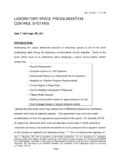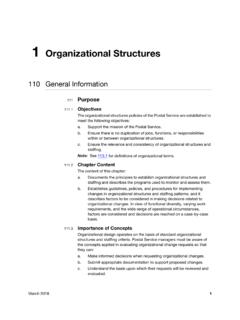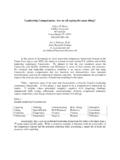Transcription of DE-93-18-1 MEASURING AND CALCULATING …
1 DE-93-18-1 Dale T. Hitchings is president of Hitchings Associates, , Midland, MI; Richard S. Shull is a manufacturing specialist atthe Dow Corning Corp., Midland, Transactions: Symposia1059 MEASURING AND CALCULATINGLABORATORY exhaust diversity THREE CASE Hitchings, , Shull, , CIHM ember ASHRAE Associate Member ASHRAEABSTRACTD iversity in laboratory exhaust systems can theo-retically be used to downsize equipment and reducecapital and operating costs. This paper provides amethod for analyzing and reporting laboratory diver-sity data and applies this method to three indicate that substantial diversity exists in realoperating facilities provided that three key motivatorsare effectively in place. These motivators are (1)facility design and function, (2) training, and (3)monitoring and enforcement.
2 It is suggested that thefume -hood -to -personnel ratio may predict thefacility diversity provided that these motivators of the small sample size reported here, moreresearch is indicated to determine the accuracy of thisratio in predicting laboratory exhaust variable-air-volume (VAV) approach to labo-ratory ventilation is becoming more popular through-out the world today. The improvements in laboratoryfume hood face velocity controls and laboratory pres-surization controls made in recent years have allowedVAV laboratory designs to become a viable and at-tractive alternative to the constant-volume-only sys-tems. Fume hood face velocity controls can make thefume hood safer for the user if properly reductions in energy consumption and op-erating costs have been realized by owners of VAVfacilities.
3 But the reduction in capital costs madepossible by taking advantage of fume hood diversityin a VAV laboratory facility is still not taken advan-tage of by most laboratory designers. The idea of ex-haust system diversity has been acknowledged bymost as theoretically sound, but it is frequentlyignored when the heating, cooling, and air movingcapacities of these systems are calculated. Engineerswho design laboratory facilities tend to be extremelyconservative when sizing the mechanical systems forlaboratories. This is due, in part, to the lack ofpublished diversity data and track records for thesesystems (fear of the unknown) and the conservative,careful attitudes prevalent in the field. This paperattempts to fill a portion of the void in actualpublished laboratory airflow diversity facility environmental control systemsand their dynamics are complex.
4 MEASURING how theyare operating can also be complex. Because of thiscomplexity, standardized methods of analysis have notbeen established. This paper also seeks to establish aframework for reporting observed diversity data. Thisframework is summarized as follows: Define diversity and other key variables. Describe the lab design and control philosophy. Describe data collection methods and accuracy. Report observed and calculated performance data. Discuss site-specific criteria that affect system use. Report conclusions. Discuss applications of these findings to other facili-ties, existing and installed exhaust capacity: The sum of themaximum operational fume hood and specific exhaustflow rates for all sources in the facility is the total in-stalled exhaust capacity. This should not be confusedwith the installed exhaust system capacity, which maybe greater or less than this sum.
5 For fume hoods withsash stops, the maximum operating flow rate is deter-mined when the sash is open to the stop. For fumehoods without sash stops, the maximum operatingflow rate is determined with the sash fully open. Forspecific exhaust sources, the maximum operating flowrate is determined when the damper is fully open. Thevolume flow rate for all fume hoods is based on thenormal operating face velocity for the facility in1060 ASHRAE Transactions: Symposiawhich they are used. In the three cases cited in thispaper the face velocity is 100 fpm ( m/s) diversity : The observed volume flow rate mea-surement expressed as a percentage of total installedexhaust capacity is the =Actual Volume FlowrateTotal Installed exhaust Capacity 100%(1) diversity data set: The complete set of diversitycalculations for all observations in the reporting pe-riod is called the diversity data set.
6 The diversity dataset is used to determine the mean observed diversity ;see Figures 3, 5, and 7 for examples of the diversitydata sets in graphical diversity data set: The original diversitydata set that has been reduced by removing data fromunoccupied time periods is called the adjusted diver-sity data set. Adjusted diversity data sets were used todetermine the upper control limits (99% designdiversity) for these systems. The effect of removingdata from unoccupied time periods makes the analysismore conservative and tends to raise the 99% designdiversity (see Table 2).Minimum observed diversity : The lowest diver-sity observed during the data collection period is theminimum observed possible operating diversity : The di-versity that occurs when all the fume hoods are closedand the specific exhausts are at their minimum is theminimum possible operating observed diversity : The mean of all ob-servations in the diversity data set is the mean ob-served adjusted diversity : The mean of all obser-vations in the adjusted diversity data set, or, the meandiversity during occupied time periods is the meanadjusted mean diversity .
7 The mean of a hypotheticaldata set consisting of the adjusted diversity data set(values during occupied periods) and all other datapoints (values during un-occupied periods) set to theminimum possible operating diversity . In otherwords, the ideal mean diversity is the mean diversityof the facility if normal usage occurred during occu-pied periods and if all the fume hoods were closedduring unoccupied Mean diversity ={( Mean Adjusted diversity ) (% of occupied hours )+ (Minimum Possible Operating diversity ) (% of unoccupied hours)}(2)Example: In facility no. 1, the mean adjusted diversity is38%. The facility is occupied for 8 hours a day, fivedays a week, for a total of 40 hours. This is 24% ofthe 168-hour week. The minimum possibleoperating diversity is 31%.
8 The unoccupied periodis the remaining 76% of the Mean diversity = ( )( ) + ( )( )= or 33%.Maximum observed diversity : The highest di-versity observed during the data collection period isthe maximum observed design diversity : The diversity of the systemthat was exceeded by only 1% of the observations inthe adjusted diversity data set. This number can alsobe interpreted as the upper control limit for a processwith a 1% rejection rate. The classical statisticalquality control methods of determining upper controllimits assume normal distribution of the , the laboratory exhaust diversity data col-lected were not normally distributed. In a non-normaldistribution, the variance or standard deviation of thesample does not describe the distribution adequatelyenough to allow mathematical calculation of the con-trol limit.
9 To allow for non-normal distributions, themethod used in this paper to determine the upper con-trol limit was to record each observation in bins of 1% diversity increments and generate a frequencydistribution. These frequencies are then summed toproduce cumulative percentages for each bin. The di-versity at which the cumulative percentage reaches99% is the 99% design diversity . See Figures 4, 6,and 8 for examples of these histograms. Thisapproach is only valid with large numbers of observa-tions, as was the case with all three facilities describedin this STUDY: FACILITY NO. 1 Facility Size & UseFacility no. 1 is an addition to a larger laboratorybuilding. The addition has a net laboratory area ofASHRAE Transactions: Symposia1061approximately 6400 ft2 (594 m2).
10 There are four sepa-rate laboratories in this addition. This facility is anindustrial research laboratory of a large chemicalcompany. Wet chemistry is done in two of the fourlaboratories and dry sample preparation and dry dis-pensing are done in the other two labs. Thirteenlaboratory personnel were using the facility during thedata-collection period. Part-time personnel wereadded to the total as a percentage of their Number, Type, and CapacityThere are a total of 16 laboratory fume hoods inthese four labs. There are two 4-ft ( m) benchtophoods, four 5-ft ( m) benchtop hoods, six 6-ft ( ) benchtop hoods, two 8-ft ( m) walk-in hoods,and two 6-ft ( m) distillation hoods. The fumehoods were all manufactured with bypasses in themthe owner opted not to close up.










